Local variations in pool etiquette and why don’t people talk to each other?
Over the Christmas break I swam in a pool I don’t often visit. It’s not a particularly easy pool to train in as it only has a wall at one end but it was the only one within easy reach of where I was. The shallow end slopes to a ‘beach’ as the pool was primarily designed as a leisure pool with a wave machine rather than a training pool. There are two small ‘islands’ – little more than posts – at the shallow end marking the end of the training section of the pool. In the early birds’ session, they put in two lane ropes to make three double lanes loosely defined as fast, medium and slow. The lane ropes are fixed to the islands. The sketch below shows the layout.
It’s a good idea when visiting a new pool to note how the regulars are swimming before diving in. I didn’t check well enough but I did at least notice that all lanes were looping clockwise, which I found a little odd as usual practice in the UK (although not in some other countries) is to alternate between clockwise and anti-clockwise. I definitely prefer the way we normally do things but wasn’t going to make a fuss so I got in and started warming up.
After a few minutes I noticed someone was catching me up so, wanting to be a considerate swimmer, as I approached the shallow end I moved to the left of the lane and stood up in the corner (next to the ‘island’) as I normally would to allow a faster swimmer to overtake. However, instead of moving to the middle of the lane to make his turn, this other swimmer also moved to the left, pushed me out of the way so he could make a turn against the ‘island’ and then kicked me as he pushed off.
Frankly, I thought this was a little excessive. A quick word to explain that the standard practice in that pool was to use the island to get a push off (rather than standing up and launching off the bottom in the middle of the lane) would have been sufficient. Sure, I figured it out from his actions and perhaps I should have been more observant but speaking to me wouldn’t have hurt (at least it wouldn’t have hurt me as much as being kicked on the thigh). I’m happy to abide by their local conventions, even if I don’t agree with them, but I prefer to have them made clear.
I didn’t like the system as it also made overtaking at the shallow end difficult. Later, once I’d warmed up, I wanted to overtake a couple of times but couldn’t. The end of the lane is usually a good place to overtake a slower swimmer. In a clockwise lane you would move to the middle (after checking there is no one coming the other way), aim to pull up alongside or slightly ahead just before you hit the wall, tumble and accelerate away. If the other person is touch-turning they will hardly need to slow down. If they’re paying attention they would move to the left and pause momentarily to let you pass. Someone moving to the left is usually an indication that they want you to pass. It was therefore confusing to start overtaking someone and then having them turn and push off diagonally into you – see sketch below.
Annoying as it was, I managed to stay calm and enjoy my swim but it does show that there is no universal pool etiquette. The best practice is to go with the flow and adopt the local conventions (although I’m sure there are exceptions to this). However, one thing I would like to change is the vow of silence many people seem to take when they swim. Why don’t swimmers in public sessions talk to each other? It could make life a lot easier.
If you haven’t yet made your resolutions for 2015 (or want another one), please add “talk to other swimmers in public training sessions.”






